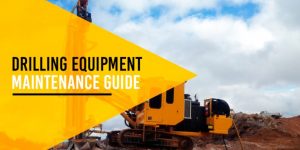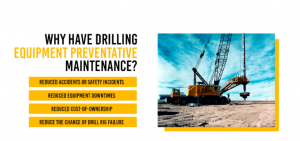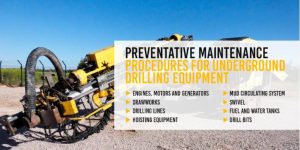A fleet of high-functioning, fully operational underground and land drilling equipment is a sight to behold. Whether top and chuck-drive coring or cross-functional drills that can tackle everything from construction to quarrying, these pieces of heavy machinery unearth true worksite digging potential.
Yet for their operators and field managers alike, maintaining heavy rig equipment to stay at full operating efficiency can be another story.
Designed for the sole purpose to bore and dig through the earth, these machines are subject to a unique set of vibrations, physical stresses, wear and tear. This means an equally unique set of preventative maintenance actions are called for — ones with a clockwork-precise schedule of inspections, testing, cleaning, lubrication and disposable part replacement.
In other words, machines that work this hard can’t be hardly cared for.
Jump to Section
- Why Have Drilling Equipment Preventative Maintenance?
- Benefits of Underground or Land Drill Equipment Inspections
- Preventative Maintenance Procedures for Underground Drilling Equipment
- Contact Prime Source for Your Land Drilling Equipment Expertise
Why Have Drilling Equipment Preventative Maintenance?
Those in the industry are no stranger to preventative maintenance and machine inspections.
There’s simply no better way to control costs, reduce risk and maintain productivity and compliance on a jobsite than through such programs. For land and underground drilling equipment especially, it’s crucial to monitor interconnected systems and components — mechanical or otherwise — according to their pre-scheduled servicing and repairs so idle times are reduced and the likelihood of machine overhaul mitigated.
The best drilling equipment maintenance schedule is tailored for you. You must consider your average work environment, climate, machine load cycles, operating times, regulatory requirements, manufacturer recommendations and more to draft maintenance primed for success. Once done, your fleet stands to reap the following rewards:
1. Reduced Accidents or Safety Incidents
Drilling fleet management doesn’t just mean taking care of your equipment — it means taking care of your operators.
Their safety and security are paramount. While rates of injuries and accidents in the drilling industry have gone down the past few years, there’s no shortage of opportunities where tighter system monitorization and component corrections could reduce incident threats even further.
Compliance comes into play here, too. Preventative maintenance schedules build proper fleet documentation and reporting into daily operations, helping bolster your compliance efforts.
2. Reduced Equipment Downtimes
It’s no surprise that preventative maintenance and inspections directly correlate with reduced machine downtime. You have a better read on your equipment, preventing small, incremental flaws and damage from scaling into serious — and costly — concerns. This, in turn, allows for better management of all equipment assets, including scheduling more strategic operation times, servicing and complementary outsourced repairs without stalling project timelines and workflows.
3. Reduced Cost-of-Ownership
Investing up-front in preventative and predictive maintenance translates into value down the road. With your inspections, you can accomplish real, value-based metrics, like cutting down on idle times and saving money on fuel costs by employing better total-engine hours. In controlling such variables, you minimize some of the most expensive yet pressing dents in your bottom line. You also catch and fix the smaller problems before they turn into bigger ones, not only preserving but in some cases restoring equipment reliability.
4. Optimize the Costs and Benefits of Asset Alterations
Replacing parts and components in your underground drilling equipment is inevitable. This takes time and resources, though, namely hard-earned capital you can’t keep spending on equipment repairs. The more frequent and unstructured these repairs are, the more you throw off budgets and timelines. No one benefits from that.
5. Reduce the Chance of Drill Rig Failure
The combined efforts of drilling rig maintenance are worth their salt. You create tighter, more compliant operations, improve on strategic project management and encourage technical expertise and buy-in from your crew. Yet alongside these logistical improvements, inspections and maintenance court improved documentation and reporting. All this maximizes fleet functionality and keeps your drill rigs doing what they were built to do, day after day.
Benefits of Underground or Land Drill Equipment Inspections
The benefits of drilling equipment inspections are compelling. As your fleet’s first line of defense, inspections initiate the early part of a machine’s broader maintenance schedule. They get real eyes and real hands on your machines, where you can assess everything from corroding steel drill lines and auger or drill bit wear to weakened safety cages. Regular inspections also manage and mitigate a range of concerns on drilling sites everywhere, from daily operations to personnel and project management.
1. Proper Crew Training and Auditing
From field and fleet managers to drill operators and specialty contractors, a crew immersed in standard preventative maintenance routines is a crew that’s safer, well-rounded and maintains integrity and project ownership.
Dedicating time to proper inspection and basic maintenance tutorials is only the beginning. Roles should be delegated, with a few crew members responsible for specific and target inspection domains. These roles should be well supported and fully trained, with test runs and audits to assure each crew person is ready to perform their part of the inspection.
2. Mature Inventory and Asset Tracking
Routine inspections satisfy another fleet benefit — they allow for a thorough and accurate documentation of an entire suite of equipment, tools, drill bits and attachments linked with the drilling rig. Routine inspections incorporate inventory cataloging into the maintenance process as a whole. Just as you’re reviewing an actual rig, you’re examining its accessories with equal attentiveness — then logging their conditions and reports accordingly.
3. Registered Preventative Maintenance Manuals
Many manufacturers group their machine upkeep recommendations by capital components, throwing together relevant parts and pieces. Routine inspections better familiarize you and your crew with these target capital components. The entire machine is then viewed as a complete, harmonious system, not a series of lone parts to cross off the day’s checklist.
For example, you don’t merely survey an engine or generator. You check the drill’s entire power capital component, ensuring a manufacturer’s recommendations are taken seriously and your own internal manuals carry all relevant details, from lubrication standards to log history.
4. Service Schedules
Merging capital component checks, manufacturer recommendations and your own tailored on-site inspection needs and deliverables, you can best draw up a drill’s entire service schedule. This gives you plenty of time to allocate what can be done in-house and what should be outsourced to a professional, one versed in the critical parts and fabrication of land drilling machinery. You save you time and money all because you planned ahead.
Preventative Maintenance Procedures for Underground Drilling Equipment
A diligent on-site maintenance program for drilling equipment can seem daunting, even with its litany of benefits and cost-savings. These specialty machines take a lot of up-front capital investment, but that investment pays for itself with proper care and maintenance.
For mines and quarries, construction, geo-surface exploration and more, drilling equipment maintenance plans would be remiss without scheduled reviews on the following critical components and consumables.
1. Engines, Motors and Generators
Drilling motors are the pulse of the drilling machine. They not only deliver a broad range of power for direct-drive machinery, but they must withstand the vibrations and elemental forces of the environments in which they’re deployed. Unexpected engine malfunctions — or total failures — are too costly to risk.
Given the diversity of powering components for land drilling equipment, a one-size approach never fits all. Your preventative maintenance on mechanical drilling engines or motors assesses its core components, from bores and strokes to flywheel teeth. It also includes regularly scheduled oil inspections and cooling fluid inspections, if part of an engine’s model. All of this adds up to ensure you have a fuel-efficient and maximum output-generating engine, one that also maintains Tier 2-4 Final standards.
2. Drawworks
Drawworks play a critical role in the lifting and vertical movements of drilling rigs. Across models and brands, drawwork design typically comes fabricated as a large mechanical winch or crankshaft, which can be powered by hydraulics, motors or even pneumatics, depending on drill size and function. This winch gathers the drilling line and must maintain smooth, even rotations without seizing or interruptions.
Components to inspect in a drawwork include many of those named above — from the winches’ horizontal rotating drum base to its chains and spools where it makes contact with drilling lines. Since it is the drawworks responsible for lifting and lowering a drill’s stem and bit, quick and seamless rotations are key.
3. Drilling Lines
Today’s drilling lines come manufactured from steel wire rope that, although ultra-strong and durable, should never be taken for granted. Habitually assess chain quality not only for surface corrosion, wear and tear but also to ensure it’s been appropriately reeved through traveling and crown block components, as well as any hooks and wire rope clamps.
Larger or more industrial-grade drilling equipment contains complementary line parts to inspect along with these steel wire ropes, blocks and hooks. This includes but is not limited to checking drill collars and pipes, if used, along with kelly components like bushing, valves and BOPs — especially if drilling for oil or gas.
4. Hoisting Equipment
A combination of components from the derrick and drawworks, your drilling equipment’s hoisting parts are next in line to routinely inspect. As the mechanical scaffolding to drilling machinery, derricks must be strong and stable. Cracks or dents should be fixed immediately to maintain structural integrity.
Likewise, drawworks’ booms, blocks, hooks and wire rope clamp placements create the network that creates the machine’s vertical hoisting capabilities in the first place. Any modifications to the quality of steel chains, blocks and more should be cataloged and treated as early as possible. Inspections of this particular drilling consumables system also allow you to reference manufacturer’s servicing recommendations. Most manufacturers cite replacing steel wire rope roughly every 1,000 operating days.
5. Mud Circulating System
The mud circulating system of your drilling equipment is part of its larger circulation mechanical network. Depending on your drilling unit and its application, the mud circulating system could be as basic as mud pumps, a suction line and possibly a shale shaker. Other, larger machines might include circulating systems with a series of pumps, lines, hoses, valves and swivels, plus other centrifugal pumps that distribute mixed drilling fluids. In either case, your mud circulation pipes must be regularly checked for leaks, cracks and deposit buildups. These could indicate problems from pressurization imbalances to unit overpumping.
6. Swivel
In rotary drills, the swivel is a crucial joint connecting the kelly components of the drilling system with a drill stem. When secure, it is an essential part of the hoisting and lifting forces of an operating drill, allowing the drill stem itself to rotate.
Swivels are hung from a rotary hook and a traveling block, again reinforcing the importance of inspecting these parts as a capital component. In some units, the swivel provides further joint connection for a rotary hose so drilling fluid, if used, can pass into the drill stem.
Swivels should never be disjointed or fractured. Rust, corrosion or surface irregularities could be an indication of unit wear and should be remedied accordingly.
7. Fuel and Water Tanks
Fuel tanks and water tanks, plus the lines, valves, filters and pumps associated with each, are imperative to maintain. Particularly with the high-impact vibrations of drilling equipment during field deployment, the smallest fractures cause significant operational and compliance ramifications if unnoticed until too it’s late.
Preventative maintenance plans should also adopt periodic oil analysis as part of wider fuel inspections. Whether done internally or through a fuel inspection partnership, this servicing could also bolster general fluids analyses important to keeping machines at peak performance.
8. Drill Bits
No drill inspection would be complete without analyzing the drill bits themselves. Without these consumables, drilling and boring simply can’t happen — creating the sort of downtime headaches fleet and site managers fear.
Many of the drill bits installed in today’s leading drilling brands are either rotary or roller-cone. Both provide dynamic cutting and circulating motions elementary to their drilling function. Yet certain drill bits can be upgraded or come outfitted to use drilling fluids on top of their brute boring force. These fluids capture the energy created by hydraulic streams to boost their drilling rates. They can subsequently dig harder or faster through more challenging ground conditions.
Drill bits come in dozens of geometric shapes, tip configurations and sizes to tackle the gamut of land drilling applications. What’s more, specialty drill bits for boring machines can be notoriously difficult to source on-the-fly, making preemptive inspections of all your equipment’s drill bits that much more important so your team can make replacement orders accordingly.
9. Hydraulic or Pneumatic Components
The diversity of hydraulic or pneumatic systems built into drilling equipment emphasizes the range of motions and power required from these machines. As such, properly inspecting their parts should be a standard inclusion in drill maintenance.
From hydraulic or pneumatic-powered winches to motors, rams and cylinders, these systems routinely help power the pumps that power or augment heavy hoisting movements. Direct-coupled systems and auxiliary pumps are easy to inspect and log the conditions of, maintaining once again your thorough attention to detail and the high standards you set for your crew and fleet.
Contact Prime Source for Your Land Drilling Equipment Expertise
At Prime Source, we pride ourselves on being the region’s premier, full-service partner for underground and land drilling parts and servicing.
Our drilling technicians average 20 years in the business. You won’t find a better team in North Carolina and the broader southeast to be your single-source provider of routine maintenance, emergency and accidental repairs, plus sourcing and acquiring parts for nearly two dozen industrial equipment brands, large and specialty.
See what our drilling experts can help you with today, or reach out directly with questions or machine concerns.






